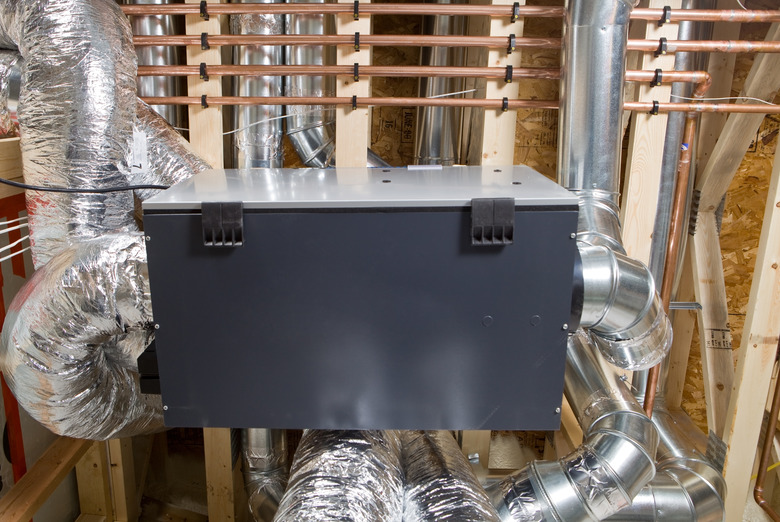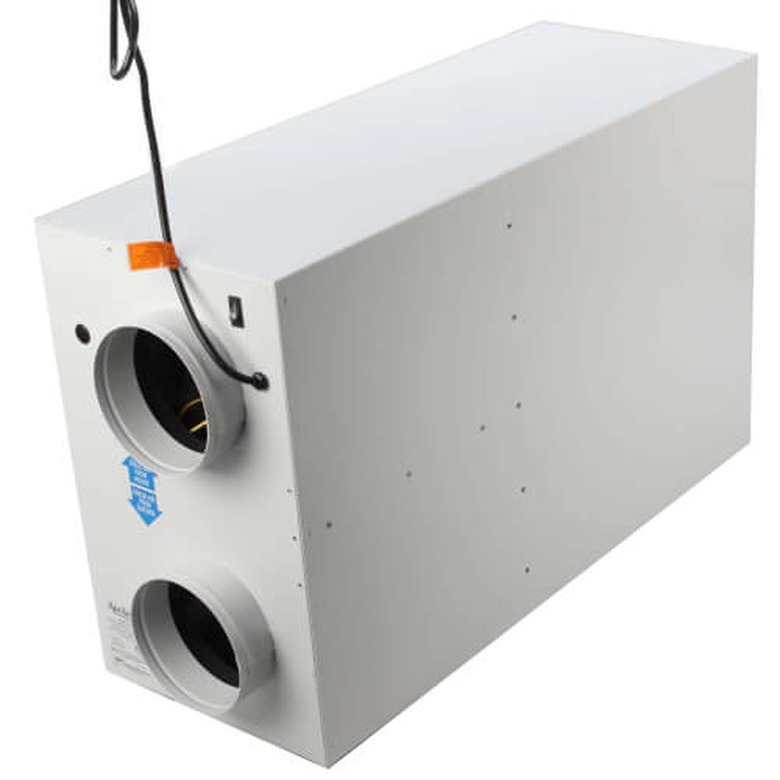Here's How To Make Sure Your Air Exchanger Is Working Properly
If your house is built according to current code standards, it probably has an air exchanger because that's the only way people in the building can get a healthy amount of fresh air to breathe. New homes are so well-sealed and insulated that it's virtually impossible for fresh air to enter and stale air to get out any other way unless, of course, you leave the windows open. That's not an option in winter, and even in summer, an air exchanger can make the climate in your home more comfortable and free from pollutants than a few open windows are able to do.
Air exchangers are stand-alone components for HVAC systems and are often used with heat pumps to precondition the air before it circulates into the home, which helps reduce energy costs. The concept behind an air exchanger isn't complicated, and it has fewer moving parts than virtually any other HVAC component, being comparable in operation to a standard exhaust fan. If you have one in your house, it's probably in the basement, and even though it's a simple machine, it needs periodic TLC. If it isn't working properly, you'll notice the effects in the temperature of your house and the indoor air quality.
How Does an Air Exchanger Work?
How Does an Air Exchanger Work?
An air exchanger consists of a rectangular metal box with two ports on either end and a blower, a pair of filters and a central core inside. The core consists of a metal or fibrous mesh that allows air to circulate in two directions without mixing. Even though the streams don't mix, they exchange heat inside the core, so it is known as the heat exchanger, and it's the central component of an air exchanger.
The blower motor operates two separate fans. One draws in fresh air from outside, passes it through the heat exchanger and circulates the exhaust air into the living space through a ductwork system. The other fan draws indoor air into the heat exchanger and exhausts it outside. The streams flow diagonally to form a cross, and the core, which is situated at the center of the cross. This forces the streams to flow through a convoluted network that draws heat from the warmer stream and transfers it to the cooler one without allowing the air currents to touch each other. This ensures that the airflow coming into the living space is warmer than the outdoor air in winter and cooler than the outdoor air in summer.
The Difference Between an ERV and an HRV
The Difference Between an ERV and an HRV
The core of a heat recovery ventilator (HRV) typically has metal fins and does not affect the humidity of the incoming air. The core of an energy recovery ventilator (ERV), on the other hand, is an absorbent material that can transfer moisture between the two air streams, which allows for humidity control as well as temperature control. The core material resembles corrugated paper, but it's actually a highly engineered resin composite material that allows heat and moisture to pass through but not air.
ERVs are generally recommended for extreme climates, which are those with hot, humid summers or dry winters. In high humidity conditions, the core passes moisture from the outside air into the air being exhausted from the living area, and in low humidity conditions, it recovers moisture from the indoor air and recirculates it back into the living space. In both cases, it's easier to maintain comfortable indoor humidity levels, which can make a big difference for homeowners and other individuals with conditions that are exacerbated by dry air.
Checking for Balanced Airflow
Checking for Balanced Airflow
If your air exchanger is working properly, the air exchange must be balanced, meaning that the stale air being drawn out of the living space is being replaced by an equal amount of fresh air. If not, there could be a net negative or positive air pressure inside the home that could affect the operation of exhaust fans and combustion devices, such as gas stoves, as well as creating indoor air quality issues. You can check the balance of your HRV or ERV using a large plastic garbage bag with a depth of 48 inches and a wire clothes hanger.
Unravel the clothes hanger, form it into a circle and wrap the opening of the bag around it using masking tape to secure it. Turn on the air exchanger and then go outside and find the exhaust air outlet, which is the one that has air blowing out of it. It's usually right next to the air intake opening, but it could also be on the other side of the house. Scrunch the bag to empty all the air and then fit the opening around the air outlet and time how long it takes for the bag to fully inflate. Eight seconds is typical.
Now, go inside and locate the air intake vent for the system. Swing the same bag you used earlier to fill it with air, fit the opening over the vent and time how long it takes the bag to completely deflate. The system is balanced if the deflation time is roughly equal to the inflation time, but there's a problem if the two times are significantly different.
Troubleshooting an Air Exchanger
Troubleshooting an Air Exchanger
If the air exchange is unbalanced, the first thing to suspect is the filters. There are two inside the air exchanger housing — one protecting the blower from outdoor air and one protecting it from indoor air — and they could be dirty. They are supposed to be cleaned every three months or so and can significantly hinder airflow if debris and dust buildup are allowed to accumulate. Blockages at the intake and outflow vent openings on the side of the house caused by small animal or wasp nests can also inhibit airflow and cause an imbalance. It's also possible that the dampers located on the air exchanger ductwork are partially closed.
An HRV doesn't transfer moisture, so when cold air from outside meets warm air from inside, moisture condenses on the heat exchanger core and drips into a drainage pan. In some cases, the core can stay wet long enough to allow mold and mildew to grow, and the telltale musty odor may circulate throughout the house. The solution is to remove the core (which simply slides out), clean it by soaking it in a mixture of cold or warm water and dish soap and then let it dry thoroughly before replacing it. This is a safe procedure with an HRV core because it's made of metal, but the core of an ERV is fragile and can be damaged if you try to manually clean it. In any case, you shouldn't have to because it's designed to transfer moisture rather than collect it.
Apart from cleaning the filters, clearing blockages and checking for leaks in the air duct, there isn't much more maintenance required from homeowners — at least that they can do themselves. It's possible for the core to rupture, which is a problem that can be solved by replacing it, and the blower or the blower motor can malfunction, and fixing that is a job for an HVAC pro. More complex problems can arise with an air exchanger coupled to a heating system or cooling system, and they should also be addressed by a pro.

